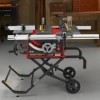Craftsman 21829 Operation Manual - Page 3
DO NOT ABUSE CORD. Never yank cord to discon - saw
 |
View all Craftsman 21829 manuals
Add to My Manuals
Save this manual to your list of manuals |
Page 3 highlights
_k WARNING." Reed and understand all insb'ue- tions, Failureto re[low all instruckions{istadbelow, may resuttin electric shock, fire andlor serious personal injury. READ ALL iNSTRUCTIONS • KNOW YOUR POWER TOOL. Read the operator's manual carefully.Learn the saw's applicationsand Iimftatioansswet[ es the specific potenti_ hazards related to this tool. • GUARD AGAINST ELECTRICAL SHOCK BY PREVENTING BODY CONTACT WITH GROUNDED SURFACES- For examp}e,pipes, radiators, ranges, refrigeratorenclesures. • KEEP GUARDS IN PLACE and in good working order. • REMOVE ADJUSTING KEYS AND WRENCHES. Form habit of checking to see that keys and adjusting wrenches are removedfrom tool before turningit on. • KEEP WORK AREA CLEAN. Cluttered areas and benches inviteaceidents. DO NOT leave tools or pieces ot wood on the saw while it is in operation. • DO NOT USE IN DANGEROUS ENVIRONMENTS. Do not usepower tools in damp or wet locationsor expose to rain. Keep the work areaweI_s_. • KEEP CHILD REN AND VISITORS AWAY. All visitors shouldwear safety g_aesasand be kept a safe distancefrom work ares. Do not let visitors osntact tool or extensioncord while operating. • MAKE WORKSHOP CHILDPROOF with padlocks and master switches, or by removings_,_'terkeys. • DON'T FORCE TOOL. It will do the job better and safer at the feed rote for which it was designed. • USE RIGHT TOOL, Don't rome the tool or attachment to do a job it was not designedfor. Don't use it for a purposenot intended. • USE THE PROPER EXTENSION CORD. Make sure your extension cord is in good condition. Use on[y a cordheavyenoughto carrythecurrenytourprodu_ will draw. An undersizedcord will cause a drop in line voltage resultingin _oesof power and overheating.A wire gauges'_e (A.W.G.)of at least 14 is recommended for an extensioncord 25 feet or less in length. If in doubt, use thenext heavier gauge. The smallerthe gauge number, the heavierthe cord. • DRESS PROPERLY. Do not wear loose clothing, gloves, neckties, or jewelry. They can get caught and draw you intomoving parts. Rubber glovesand nonskidfoo[wser are recommendedwhen working outdoors.Alse wear protecl:'Nehair osver;ng to contain long hak. • ALWAYSWEAR SAFETYG_ESWITI-I SIDE SHIELDS. Everyday eyeglasseshave onlyimpact- resistantlenses, they are NOT safety gtaseas. • SECURE WORK, Use clamps or avise to hold work when pc_ctical._fs safert_n using your han_ an _ees both hands to operate tool. • DON'T OVERREACH. Keep properfootingand ba_nco at sit times. • MAINTAIN TOOLS WITH CARE. Kesp tools sherp and clean for better and safer performanca.FoJiow instructionsfor lubricatingand changingaccessories. • DISCONNECT TOOLS. When not in use, before servicing,or when changingaLl_chmants,blades, bits, cutters, etc., an tools should be disconnected. • AVOID ACCIDENTAL STARTING. Be sure switch is off when plugging in any tooL • USE RECOMMENDED ACCESSORIES. Consult the operator'smanual for recommendedaccessories.The use of improperaccessoriesmay risk injury. • NEVER STAND ON TOOL, Serious injurycould occur if the tool is tipped or if the cuttingtoo[ is unintention_lly con_.cted. • CHECK DAMAGED PARTS. Before further use of the toot,a guard or other part that is damaged should be carefuttychecked to determine that it will operate propedyand perform its intendedfunction. Check for al{gnn_notf movingparts, b(n_ingot movingparts, breakageof parts, mounting and anyother conditioP.s that may affect its oparatien. A guard or o_er part _at is damaged must be properlyrepairedor replaced by _.nau'thofized service centerto avoid risk of personal ir_u_ • USE THE RIGHT DIRECTION OF FEED. Feed work into a blade or cutler against the directionot rotation of bladeor cutter only. • NEVER LEAVE TOOL RUNNING UNATTENDED. TURN THE POWER OFF. Don't leave tool until it comes to a complete stop, • PROTECT YOUR LUNGS. Wear a face or dust mask if the cutting operation is dusty. • PROTECT YOUR HEARING.Wear'hearing protection dorJng exte_de_ periodsofopera,on, • DO NOT ABUSE CORD. Never yank cord to disconnect from receptacle. Keep cord from heat, oil, and sharp edges. • USE OUTDOOR EXTENSION CORDS, When tool is used ou_oore, use onlyextensbn cordswith approved ground osnne_ion tha_are intended for use outdoors and so m_rked. • ALWAYS KEEP THE BLADE GUARD AND RIVING KNIFE/SPREADER/SPLITTER IN PLACE and in working order. • KEEP BLADES CLEAN, SHARP, ANDWITH SUFFICIENT SET. Sharp blades minimize stalling and kickback. • KEEP HANDS AWAY FROM CLrt-r|NG AREA. Keep hands away from blades. Do not reach underneath












